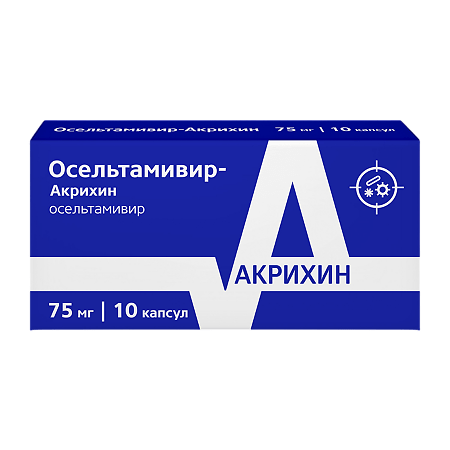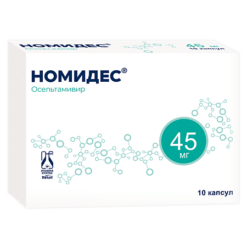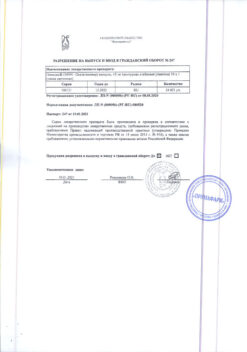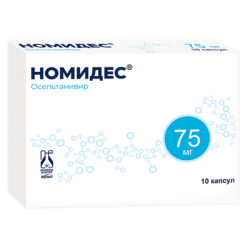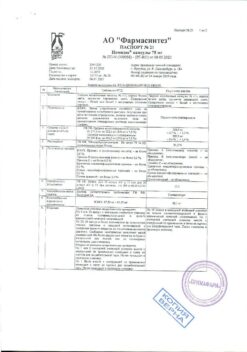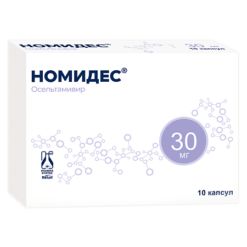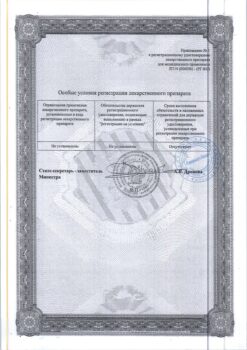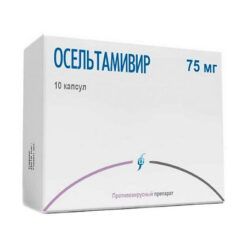No products in the cart.
Description
Mechanism of action
Antiviral drug. Oseltamivir is a prodrug, its active metabolite (oseltamivir carboxylate, OC) is an effective and selective inhibitor of influenza virus neuraminidase type A and B – the enzyme that catalyzes the release of newly formed viral particles from infected cells, their penetration into uninfected cells of respiratory epithelium and further spread of virus in the body. Inhibits influenza virus growth in vitro and suppresses virus replication and pathogenicity in vivo, reduces release of influenza A and B viruses from organism.
OC concentration required for 50% neuraminidase inhibition (IC50) is 0.1-1.3 nM for influenza A virus and 2.6 nM for influenza B virus. Median IC50 values for influenza B virus are slightly higher and constitutes 8.5 nM.
Clinical efficacy
In the conducted studies oseltamivir had no effect on influenza antibody formation, including on antibody production in response to administration of inactivated influenza vaccine.
Studies of natural influenza infection.
In clinical studies of oseltamivir conducted during seasonal influenza infection, patients were started on oseltamivir no later than 40 h after the first symptoms of influenza infection appeared. 97% of patients were infected with influenza A virus and 3% of patients were infected with influenza B virus.
Oseltamivir significantly shortened the period of clinical manifestations of influenza infection (by 32 h). In patients with a confirmed diagnosis of influenza who took oseltamivir, the severity of the disease, expressed as the area under the curve for the total index of symptoms, was 38% lower compared to patients receiving placebo. Moreover, in young patients without comorbidities oseltamivir reduced by about 50% the incidence of flu complications requiring antibiotics (bronchitis, pneumonia, sinusitis, otitis media).
There was clear evidence of efficacy of the drug with respect to secondary efficacy criteria relating to antiviral activity: oseltamivir caused both a shortening of the time of virus release from the body and a reduction in the area under the “viral titers-time” curve.
Data obtained in a study on oseltamivir therapy in elderly and senile patients show that administration of oseltamivir at a dose of 75 mg twice daily for 5 days was accompanied by clinically significant reduction in the median period of clinical manifestations of influenza infection, similar to that in adult patients of younger age, but differences did not reach statistical significance. In another study, influenza patients older than 13 years with concomitant chronic diseases of the cardiovascular and/or respiratory systems received oseltamivir in the same dosing regimen or placebo.
There were no differences in the median period before reduction of clinical manifestations of influenza infection in the oseltamivir and placebo groups, but the period of fever when taking oseltamivir was shorter by about 1 day. The proportion of patients excreting the virus on days 2 and 4 became significantly lower. The safety profile of oseltamivir in patients in the risk group did not differ from that in the general population of adult patients.
Influenza treatment in children
In children aged 1-12 years (mean age 5.3 years) who had fever (≥37.8°C) and one of the respiratory system symptoms (cough or rhinitis) while the influenza virus was circulating in the population, a double-blind, placebo-controlled study was conducted. Sixty-seven percent of patients were infected with influenza A virus and 33% of patients were infected with influenza B virus. The drug oseltamivir (when taken no later than 48 h after the first symptoms of influenza infection) significantly reduced the duration of illness (by 35.8 h) compared with placebo. Duration of illness was defined as the time until coughing, nasal congestion, disappearance of fever, and return to normal activity. The incidence of acute otitis media was reduced by 40% in the children treated with oseltamivir compared to the placebo group. Recovery and return to normal activity occurred almost 2 days earlier in children receiving oseltamivir compared to the placebo group.
Another study involved children aged 6-12 years with bronchial asthma; 53.6% of patients had influenza infection confirmed serologically and/or in culture. The median duration of illness in the group of patients receiving oseltamivir did not decrease significantly. But by the last 6 days of therapy with oseltamivir, forced expiratory volume in 1 second (FEF1) increased by 10.8% compared with 4.7% in patients receiving placebo (p=0.0148).
Influenza prevention in adults and adolescents
The preventive efficacy of oseltamivir in natural influenza A and B infection has been proven in 3 separate phase III clinical trials. About 1% of patients became ill with influenza while taking oseltamivir. Oseltamivir also significantly reduced the frequency of virus excretion and prevented transmission from one family member to another.
Adults and adolescents who were in contact with a sick family member began taking oseltamivir within two days of the onset of flu symptoms in family members and continued it for 7 days, which significantly reduced the frequency of flu in contacted individuals by 92 percent.
In unvaccinated and generally healthy adults aged 18-65 years, taking oseltamivir during an influenza epidemic significantly reduced the incidence of influenza (by 76%). Patients took the drug for 42 days.
In elderly and elderly persons in nursing homes, 80% of whom had been vaccinated before the season when the study was conducted, oseltamivir significantly reduced influenza morbidity by 92%. In the same study, oseltamivir significantly (86%) reduced the incidence of flu complications: bronchitis, pneumonia, and sinusitis. Patients took the drug for 42 days.
Influenza prevention in children Prophylactic efficacy of oseltamivir in natural influenza infection was demonstrated in children from 1 to 12 years after contact with a sick family member or someone in the permanent environment. The primary efficacy parameter was the frequency of laboratory-confirmed influenza infection. In children who received oseltamivir /powder for oral suspension preparation/ in the dose from 30 to 75 mg once a day for 10 days and did not excrete the virus initially, the frequency of laboratory-confirmed influenza infection decreased to 4% (2/47) compared with 21% (15/70) in the placebo group.
Influenza prophylaxis in immunocompromised subjects
In immunocompromised subjects with seasonal influenza infection and no viral release at baseline, prophylactic use of oseltamivir resulted in a reduction in the frequency of laboratory-confirmed influenza infection with clinical symptomatology to 0.4% (1/232) compared with 3% (7/231) in the placebo group. Laboratory-confirmed influenza infection accompanied by clinical symptoms was diagnosed in the presence of oral fever above 37.2°C, cough and/or acute rhinitis (all reported on the same day while taking the drug/placebo), and a positive reverse-transcriptase polymerase chain reaction for influenza virus RNA.
Resistance
Clinical Studies
In all OC-resistant patients, carriage was transient, had no effect on virus elimination, and did not cause worsening of clinical condition.
Patient population
Patients with resistance mutations
Phenotyping* Gene and phenotyping*
Adults and adolescents 4/1245 (0.32%) 5/1245 (0.4%)
Children (1-12 years) 19/464 (4.1%) 25/464 (5.4%)
* Complete genotyping was not done in any of the studies.
No cases of resistance to the drug were noted in individuals with normal immune system function when oseltamivir was administered for post-exposure prophylaxis (7 days), family contact prophylaxis (10 days), and seasonal prophylaxis (42 days).
In a 12-week seasonal prophylaxis study in immunocompromised individuals, no cases of resistance were also observed.
Data from individual clinical cases and observational studies
Naturally occurring mutations of influenza A and B viruses that had reduced sensitivity to oseltamivir were found in patients not receiving oseltamivir. In 2008, an H275Y substitution type mutation leading to resistance was found in more than 99% of the 2008 H1N1 virus strains circulating in Europe. The 2009 H1N1 influenza virus (“swine flu”) was sensitive to oseltamivir in most cases. Oseltamivir-resistant strains were found in individuals with normal immune system function and immunocompromised individuals taking oseltamivir. The degree of desensitization to oseltamivir and the frequency of such viruses may vary by season and region. Resistance to oseltamivir was found in patients with pandemic H1N1 influenza who received the drug for both treatment and prevention.
The incidence of resistance may be higher in younger patients and immunocompromised patients. Oseltamivir-resistant laboratory strains of influenza viruses and influenza viruses from patients treated with oseltamivir carry N1 and N2 neuraminidase mutations. Mutations leading to resistance are often specific to the neuraminidase subtype.
When deciding on the use of oseltamivir, the seasonal sensitivity of the influenza virus to the drug should be considered (the latest information can be found on the WHO website).
Preclinical data
Preclinical data based on standard pharmacological safety, genotoxicity and chronic toxicity studies did not reveal any particular risk to humans.
Carcinogenicity: the results of 3 studies of carcinogenic potential (two 2-year studies in rats and mice for oseltamivir and one 6-month study in Tg:AC transgenic mice for the active metabolite) were negative.
Mutagenicity: Standard genotoxic tests for oseltamivir and the active metabolite were negative.
Effect on fertility: oseltamivir at a dose of 1500 mg/kg/day had no effect on the generative function of male and female rats.
Teratogenicity: In studies of teratogenicity of oseltamivir at doses up to 1500 mg/kg/day (in rats) and up to 500 mg/kg/day (in rabbits) no effect on embryo-fetal development was found. In studies of antenatal and postnatal development in rats, when oseltamivir was administered at a dose of 1500 mg/kg/day, an increase in the period of labor was observed: the safety limit between human exposure and the maximum no-effect dose in rats (500 mg/kg/day) was 480 times higher for oseltamivir, and 44 times higher for its active metabolite. Exposure in the fetus was 15-20% of that in the mother.
Other: oseltamivir and its active metabolite penetrate into the milk of lactating rats.
According to limited data oseltamivir and its active metabolite penetrate into human breast milk. Based on extrapolation of data from animal studies, their amounts in breast milk may be 0.01 mg/day and 0.3 mg/day, respectively.
Approximately 50% of guinea pigs tested exhibited skin sensitization in the form of erythema when maximum doses of the active substance oseltamivir were administered. Reversible eye irritation in rabbits was also found.
While very high oral single doses (657 mg/kg and above) of oseltamivir had no effect on adult rats, these doses had toxic effects on immature 7-day-old baby rats, including death of animals. No undesirable effects were observed when chronically administered at a dose of 500 mg/kg/day from 7 to 21 days postnatal period.
Pharmokinetics
Absorption
Oseltamivir is readily absorbed in the gastrointestinal tract and extensively converted to the active metabolite by hepatic and intestinal esterases. Plasma concentrations of the active metabolite are determined within 30 minutes, time to reach maximum concentrations of 2-3 hours, and are more than 20 times higher than concentrations of prodrug. At least 75% of the ingested dose reaches the systemic bloodstream as the active metabolite, less than 5% as the parent drug. Plasma concentrations of both prodrug and active metabolite are proportional to the dose and do not depend on food intake.
Distribution
Distribution volume (Vss) of active metabolite is 23 l.
According to animal studies, after oral administration oseltamivir its active metabolite was detected in all major foci of infection (lungs, bronchial waters, nasal mucosa, middle ear and trachea) in concentrations ensuring antiviral effect.
Binding of active metabolite with plasma proteins – 3%. Binding of prodrug to plasma proteins is 42%, which is not enough to cause significant drug interactions.
Metabolism
Oseltamivir is extensively converted to active metabolite under the action of esterases, mainly located in the liver. Neither oseltamivir nor the active metabolite are substrates or inhibitors of cytochrome P450 isoenzymes.
Excretion
Excreted (>90%) as the active metabolite mainly by the kidneys. The active metabolite undergoes no further transformation and is excreted by the kidneys (>99%) by glomerular filtration and tubular secretion. Renal clearance (18.8 l/h) exceeds glomerular filtration rate (7.5 l/h), indicating that the drug is also excreted by tubular secretion. Less than 20% of the drug taken is excreted through the intestine. The elimination half-life of the active metabolite is 6-10 hours.
Pharmacokinetics in special groups of patients
Patients with kidney disease
Administration of oseltamivir (100 mg twice daily for 5 days) in patients with various degrees of renal impairment the area under curve “concentration of active metabolite in plasma – time” (AUC oseltamivir carboxylate) is inversely proportional to the decrease of renal function.
Pharmacokinetics of oseltamivir in patients with terminal renal failure (with creatinine clearance ≤10 ml/min) who are not on dialysis has not been studied.
Patients with liver damage
The data obtained in vitro and in animal studies about the absence of a significant increase in the AUC of oseltamivir or its active metabolite in liver dysfunction of mild to moderate severity have been confirmed in clinical trials. Safety and pharmacokinetics of oseltamivir in patients with severe hepatic impairment have not been studied.
Patients of elderly and senile age
In elderly and senile patients (65-78 years) the exposure of the active metabolite in equilibrium is 25-35% higher than in younger patients when similar doses of oseltamivir are prescribed. The half-life of the drug in elderly and senile patients was not significantly different from that in younger patients. Taking into account the data on drug exposure and tolerability in elderly and senile patients, no dose adjustment is required for treatment and prophylaxis of influenza.
Children aged 1 to 8 years and adolescents
Pharmacokinetics of oseltamivir was studied in children aged 1 to 16 years in a single administration pharmacokinetic study and in a clinical study to study multiple administration of the drug in a small number of children aged 3-12 years.
The body weight-adjusted excretion rate of the active metabolite is higher in young children than in adults, resulting in a lower AUC in relation to a specific dose. Administration of the drug at a dose of 2 mg/kg and single doses of 30 mg or 45 mg in accordance with the dosing recommendations provides the same AUC of oseltamivir carboxylate as is achieved in adults after a single dose of a capsule containing 75 mg of the drug (equivalent to approximately 1 mg/kg). Pharmacokinetics of oseltamivir in children over 12 years is the same as in adults.
Indications
Indications
Treatment of influenza in adults and children over 1 year of age.
Prevention of influenza in adults and adolescents over 12 years of age who are in groups at increased risk of infection with the virus (in military units and large production teams, in debilitated patients).
Prevention of influenza in children over 1 year of age.
Pharmacological effect
Pharmacological effect
Mechanism of action
Antiviral drug. Oseltamivir is a prodrug, its active metabolite (oseltamivir carboxylate, OK) is an effective and selective inhibitor of neuraminidase of influenza viruses type A and B – an enzyme that catalyzes the process of releasing newly formed viral particles from infected cells, their penetration into uninfected cells of the respiratory tract epithelium and further spread of the virus in the body. Inhibits the growth of the influenza virus in vitro and suppresses the replication of the virus and its pathogenicity in vivo, reduces the release of influenza A and B viruses from the body.
The concentration of OC required to inhibit neuraminidase by 50% (IC50) is 0.1-1.3 nM for influenza A virus and 2.6 nM for influenza B virus. The median IC50 value for influenza B virus is slightly higher and is 8.5 nM.
Clinical effectiveness
In studies conducted, oseltamivir had no effect on the formation of anti-influenza antibodies, including the production of antibodies in response to the administration of an inactivated influenza vaccine.
Studies of natural influenza infection.
In clinical studies of oseltamivir conducted during seasonal influenza infection, patients began receiving oseltamivir no later than 40 hours after the first symptoms of influenza infection appeared. 97% of patients were infected with influenza A virus and 3% of patients with influenza B virus.
Oseltamivir significantly shortened the period of clinical manifestations of influenza infection (by 32 hours). Patients with confirmed influenza who received oseltamivir had 38% less disease severity, expressed as the area under the curve for the total symptom index, compared with patients who received placebo. Moreover, in young patients without concomitant diseases, oseltamivir reduced by approximately 50% the incidence of influenza complications requiring the use of antibiotics (bronchitis, pneumonia, sinusitis, otitis media).
There was clear evidence of the drug’s effectiveness in relation to secondary efficacy criteria related to antiviral activity: oseltamivir caused both a shortening of the time of viral shedding from the body and a decrease in the area under the viral titer-time curve.
Data obtained in a study on oseltamivir therapy in elderly and senile patients show that taking oseltamivir at a dose of 75 mg 2 times a day for 5 days was accompanied by a clinically significant decrease in the median period of clinical manifestations of influenza infection, similar to that in younger adult patients, but the differences did not reach statistical significance. In another study, influenza patients over 13 years of age who had concomitant chronic diseases of the cardiovascular and/or respiratory systems received oseltamivir in the same dosage regimen or placebo.
There were no differences in the median period until clinical manifestations of influenza infection decreased in the oseltamivir and placebo groups, however, the period of fever when taking oseltamivir was shortened by approximately 1 day. The proportion of patients shedding virus on days 2 and 4 became significantly smaller. The safety profile of oseltamivir in patients at risk did not differ from that in the general population of adult patients.
Treatment of influenza in children
A double-blind, placebo-controlled study was conducted in children aged 1-12 years (mean age 5.3 years) who had fever (≥37.8°C) and one of the respiratory symptoms (cough or rhinitis) during the period of influenza virus circulation in the population. 67% of patients were infected with influenza A virus and 33% of patients with influenza B virus. The drug oseltamivir (when taken no later than 48 hours after the onset of the first symptoms of influenza infection) significantly reduced the duration of the disease (by 35.8 hours) compared with placebo. The duration of the disease was defined as the time until cough, nasal congestion, resolution of fever, and return to normal activity were resolved. In the group of children receiving oseltamivir, the incidence of acute otitis media decreased by 40% compared to the placebo group. Recovery and return to normal activities occurred almost 2 days earlier in children receiving oseltamivir compared to the placebo group.
Another study involved children aged 6-12 years with asthma; 53.6% of patients had influenza infection confirmed by serology and/or culture. The median duration of disease in the group of patients receiving oseltamivir did not decrease significantly. But by the last 6th day of oseltamivir therapy, forced expiratory volume in 1 second (FEV1) increased by 10.8% compared to 4.7% in patients receiving placebo (p = 0.0148).
Prevention of influenza in adults and adolescents
The prophylactic efficacy of oseltamivir against natural influenza A and B infections was demonstrated in 3 separate phase III clinical studies. While taking oseltamivir, about 1% of patients fell ill with the flu. Oseltamivir also significantly reduced the frequency of virus shedding and prevented transmission of the virus from one family member to another.
Adults and adolescents who were in contact with an ill family member started taking oseltamivir within two days of the onset of flu symptoms in family members and continued it for 7 days, which significantly reduced the incidence of influenza in contacts by 92%.
In unvaccinated and generally healthy adults aged 18–65 years, taking oseltamivir during an influenza epidemic significantly reduced the incidence of influenza (by 76%). Patients took the drug for 42 days.
In elderly and senile residents of nursing homes, 80% of whom were vaccinated before the season when the study was conducted, oseltamivir significantly reduced the incidence of influenza by 92%. In the same study, oseltamivir significantly (by 86%) reduced the incidence of influenza complications: bronchitis, pneumonia, sinusitis. Patients took the drug for 42 days.
Prevention of influenza in children The preventive effectiveness of oseltamivir against natural influenza infection has been demonstrated in children from 1 year to 12 years after contact with a sick family member or someone from their immediate environment. The main efficacy parameter was the incidence of laboratory-confirmed influenza infection. In children who received oseltamivir (powder for oral suspension) at a dose of 30 to 75 mg once daily for 10 days and did not shed virus at baseline, the incidence of laboratory-confirmed influenza decreased to 4% (2/47) compared with 21% (15/70) in the placebo group.
Preventing influenza in immunocompromised individuals
In immunocompromised individuals with seasonal influenza infection and in the absence of viral shedding initially, prophylactic use of oseltamivir led to a decrease in the frequency of laboratory-confirmed influenza infection accompanied by clinical symptoms to 0.4% (1/232) compared with 3% (7/231) in the placebo group. Laboratory-confirmed influenza infection accompanied by clinical symptoms was diagnosed by the presence of an oral temperature above 37.2°C, cough and/or acute rhinitis (all recorded on the same day while taking the drug/placebo), as well as a positive reverse transcriptase polymerase chain reaction for influenza virus RNA.
Resistance
Clinical studies
In all patients carrying OK-resistant virus, carriage was temporary, did not affect the elimination of the virus and did not cause a deterioration in the clinical condition.
Patient population
Patients with mutations leading to resistance
Phenotyping* Geno- and phenotyping*
Adults and adolescents 4/1245 (0.32%) 5/1245 (0.4%)
Children (1-12 years old) 19/464 (4.1%) 25/464 (5.4%)
*Complete genotyping was not performed in any of the studies.
When taking oseltamivir for the purpose of post-exposure prophylaxis (7 days), prophylaxis of family contacts (10 days) and seasonal prophylaxis (42 days) in persons with normal immune system function, no cases of drug resistance were observed.
In a 12-week seasonal prophylaxis study, no cases of resistance emerged in immunocompromised individuals.
Data from individual clinical cases and observational studies
In patients who did not receive oseltamivir, naturally occurring mutations of influenza A and B viruses were found that had reduced sensitivity to oseltamivir. In 2008, the H275Y substitution mutation leading to resistance was found in more than 99% of 2008 H1N1 virus strains circulating in Europe. The 2009 H1N1 influenza virus (“swine flu”) was susceptible to oseltamivir in most cases. Oseltamivir-resistant strains have been found in individuals with normal immune system function and in immunocompromised individuals taking oseltamivir. The degree of reduction in sensitivity to oseltamivir and the frequency of occurrence of similar viruses may vary depending on the season and region. Resistance to oseltamivir has been detected in patients with pandemic H1N1 influenza who received the drug for both treatment and prophylaxis.
The incidence of resistance may be higher in younger patients and immunocompromised patients. Oseltamivir-resistant laboratory strains of influenza viruses and influenza viruses from patients treated with oseltamivir carry neuraminidase N1 and N2 mutations. Mutations leading to resistance are often specific to the neuraminidase subtype.
When deciding whether to use oseltamivir, the seasonal sensitivity of the influenza virus to the drug should be taken into account (the latest information can be found on the WHO website).
Preclinical data
Preclinical data based on standard pharmacological safety, genotoxicity and chronic toxicity studies do not indicate any particular hazard to humans.
Carcinogenicity: Results from 3 carcinogenic potential studies (two 2-year studies in rats and mice for oseltamivir and one 6-month study in Tg:AC transgenic mice for the active metabolite) were negative.
Mutagenicity: Standard genotoxicity tests for oseltamivir and the active metabolite were negative.
Effect on fertility: oseltamivir at a dose of 1500 mg/kg/day did not affect the generative function of male and female rats.
Teratogenicity: in studies examining the teratogenicity of oseltamivir at a dose of up to 1500 mg/kg/day (in rats) and up to 500 mg/kg/day (in rabbits), no effect on embryo-fetal development was found. In studies examining the antenatal and postnatal periods of development in rats, when oseltamivir was administered at a dose of 1500 mg/kg/day, an increase in the period of labor was observed: the safety limit between exposure in humans and the maximum non-effecting dose in rats (500 mg/kg/day) for oseltamivir was 480 times higher, and for its active metabolite – 44 times higher. Exposure in the fetus was 15-20% of that in the mother.
Other: oseltamivir and the active metabolite are excreted into the milk of lactating rats.
Limited data indicate that oseltamivir and its active metabolite are excreted in human breast milk. Based on the results of extrapolation of data obtained from animal studies, their amount in breast milk may be 0.01 mg/day and 0.3 mg/day, respectively.
In approximately 50% of tested guinea pigs, when administered maximum doses of the active substance oseltamivir, skin sensitization in the form of erythema was observed. Reversible eye irritation in rabbits has also been identified.
While very high single oral doses (657 mg/kg and above) of oseltamivir had no effect on adult rats, these doses were toxic to immature 7-day-old rat pups, including death. No undesirable effects were observed with chronic administration at a dose of 500 mg/kg/day from 7 to 21 days of the postnatal period.
Pharmakinetics
Suction
Oseltamivir is easily absorbed from the gastrointestinal tract and is extensively converted into an active metabolite under the action of hepatic and intestinal esterases. Concentrations of the active metabolite in plasma are determined within 30 minutes, the time to reach maximum concentration is 2-3 hours, and are more than 20 times higher than the concentrations of the prodrug. At least 75% of the dose taken orally enters the systemic circulation in the form of an active metabolite, less than 5% in the form of the parent drug. Plasma concentrations of both the prodrug and the active metabolite are dose proportional and independent of food intake.
Distribution
Volume of distribution (Vss) of the active metabolite – 23 l.
According to studies conducted on animals, after oral administration of oseltamivir, its active metabolite was detected in all main foci of infection (lungs, bronchial lavage, nasal mucosa, middle ear and trachea) in concentrations providing an antiviral effect.
The connection of the active metabolite with plasma proteins is 3%. The binding of the prodrug to plasma proteins is 42%, which is not enough to cause significant drug interactions.
Metabolism
Oseltamivir is extensively converted to its active metabolite by esterases located primarily in the liver. Neither oseltamivir nor the active metabolite are substrates or inhibitors of cytochrome P450 isoenzymes.
Removal
It is excreted (>90%) as an active metabolite mainly by the kidneys. The active metabolite does not undergo further transformation and is excreted by the kidneys (>99%) by glomerular filtration and tubular secretion. Renal clearance (18.8 l/h) exceeds the glomerular filtration rate (7.5 l/h), indicating that the drug is also eliminated by tubular secretion. Less than 20% of the drug taken is excreted through the intestines. The half-life of the active metabolite is 6-10 hours.
Pharmacokinetics in special groups of patients
Patients with kidney damage
When oseltamivir (100 mg twice daily for 5 days) is used in patients with varying degrees of kidney damage, the area under the active metabolite plasma concentration-time curve (oseltamivir carboxylate AUC) is inversely proportional to the decrease in renal function.
The pharmacokinetics of oseltamivir in patients with end-stage renal disease (creatinine clearance ≤10 mL/min) not on dialysis have not been studied.
Patients with liver damage
Data obtained in vitro and in animal studies that there was no significant increase in the AUC of oseltamivir or its active metabolite in mild to moderate liver dysfunction were confirmed in clinical studies. The safety and pharmacokinetics of oseltamivir in patients with severe hepatic impairment have not been studied.
Elderly and senile patients
In elderly and senile patients (65-78 years), the exposure of the active metabolite at steady state is 25-35% higher than in younger patients when similar doses of oseltamivir are prescribed. The half-life of the drug in elderly and senile patients did not differ significantly from that in younger patients. Taking into account the data on the exposure of the drug and its tolerability in elderly and senile patients, no dose adjustment is required in the treatment and prevention of influenza.
Children aged 1 to 8 years and teenagers
The pharmacokinetics of oseltamivir were studied in children aged 1 to 16 years in a single-dose pharmacokinetic study and in a multiple-dose clinical trial in a small number of children aged 3-12 years.
The rate of elimination of the active metabolite, adjusted for body weight, is higher in young children than in adults, resulting in lower AUCs relative to a specific dose. Administration of the drug at a dose of 2 mg/kg and single doses of 30 mg or 45 mg in accordance with dosing recommendations provides the same AUC of oseltamivir carboxylate as that achieved in adults after a single dose of a 75 mg capsule (equivalent to approximately 1 mg/kg). The pharmacokinetics of oseltamivir in children over 12 years of age is the same as in adults.
Special instructions
Special instructions
Mental disorders
Mental disorders, seizures, and delirium-like neuropsychiatric disorders have been reported in patients (mainly children and adolescents) taking oseltamivir to treat influenza. These cases rarely involved life-threatening actions. The role of oseltamivir in the development of these phenomena is unknown. Similar neuropsychiatric disorders were also noted in patients with influenza who did not receive oseltamivir.
The risk of developing neuropsychiatric disorders in patients receiving oseltamivir does not exceed that in patients with influenza not receiving antiviral drugs.
It is recommended to carefully monitor the condition and behavior of patients, especially children and adolescents, in order to identify signs of abnormal behavior and assess the risk of continuing to take the drug if these phenomena develop.
There is no data on the effectiveness of oseltamivir for any diseases caused by pathogens other than influenza A and B viruses.
The drug Oseltamivir-Akrikhin is not a replacement for vaccination.
Prophylactic use of the drug Oseltamivir-Akrikhin is possible according to epidemiological indications.
Oseltamivir in this dosage form should not be administered to children under 1 year of age.
Instructions for use, handling and disposal
The release of medicinal products into the environment should be minimized. The drug should not be disposed of with wastewater or household waste. Where possible, special systems should be used to dispose of medications.
Impact on the ability to drive vehicles and machinery
Studies have not been conducted to study the effect of the drug on the ability to drive vehicles and engage in other potentially dangerous activities that require increased concentration, attention and speed of psychomotor reactions. Based on the safety profile, the impact of oseltamivir on these activities is unlikely.
Active ingredient
Active ingredient
Oseltamivir
Composition
Composition
1 capsule contains:
Active ingredient:
oseltamivir phosphate in terms of 100% substance – 98.5 mg, which is equivalent to 75 mg of oseltamivir;
Excipients:
pregelatinized starch,
povidone (type K30),
croscarmellose sodium,
talc,
sodium stearyl fumarate.
Hard gelatin capsule [body: black iron oxide dye, titanium dioxide, gelatin; cap: red iron oxide dye, yellow iron oxide dye, titanium dioxide, gelatin].
Contraindications
Contraindications
Hypersensitivity to oseltamivir or any component of the drug.
End-stage renal failure (creatinine clearance ≤ 10 ml/min).
Children under 1 year of age.
Severe liver failure.
With caution
Pregnancy, breastfeeding period.
Use during pregnancy and breastfeeding
There have been no controlled studies in pregnant women. However, post-marketing and observational studies have demonstrated the benefit of the proposed standard dosing regimen in this patient population. The results of pharmacokinetic analysis showed lower exposure of the active metabolite (by approximately 30% during all trimesters of pregnancy) in pregnant women compared to non-pregnant women.
However, the calculated exposure value remains above the inhibitory concentrations (IC95 value) and therapeutic values for many influenza virus strains. Changing the dosage regimen in pregnant women during therapy or prophylaxis is not recommended. There were no direct or indirect adverse effects of the drug on pregnancy, embryo-fetal or postnatal development. When prescribing oseltamivir to pregnant women, safety data should be taken into account, as well as the course of pregnancy and the pathogenicity of the circulating influenza virus strain.
During preclinical studies, oseltamivir and the active metabolite were excreted into the milk of lactating rats. Data on the excretion of oseltamivir into breast milk in humans and the use of oseltamivir in nursing women are limited. Oseltamivir and its active metabolite pass into breast milk in small quantities, creating subtherapeutic concentrations in the blood of the infant. When prescribing oseltamivir to nursing women, concomitant illness and the pathogenicity of the circulating influenza virus strain should also be taken into account.
During pregnancy and breastfeeding, oseltamivir is used only if the expected benefit to the mother outweighs the potential risk to the fetus and child.
Side Effects
Side Effects
Clinical studies
In influenza treatment studies in adults/adolescents, the most common adverse reactions (APs) were nausea, vomiting, and headache.
Most HP occurred on the first or second day of treatment and resolved spontaneously within 1-2 days. In influenza prevention studies in adults and adolescents, the most common HPs were nausea, vomiting, headache, and pain. Vomiting was the most common symptom in children. The described adverse reactions in most cases did not require discontinuation of the drug.
Treatment and prevention of influenza in adults and adolescents
Table 1 shows the HPs that occurred most frequently (≥ 1%) with the recommended dose of oseltamivir in influenza prevention and treatment studies in adults and adolescents (75 mg twice daily for 5 days for treatment and 75 mg once daily for up to 6 weeks for prophylaxis), and which were at least 1% higher in incidence compared with placebo. Studies on the treatment of influenza included adults/adolescents without concomitant pathology and patients at risk, i.e. patients at high risk of developing complications of influenza (elderly and senile patients, patients with chronic heart or respiratory diseases). In general, the safety profile in patients at risk was consistent with that in adults/adolescent patients without comorbidities.
In influenza prevention studies, the safety profile in patients receiving the recommended dose of oseltamivir (75 mg once daily for up to 6 weeks) was no different from that in influenza treatment studies, despite longer dosing.
Table 1. Percentage of adults/adolescents with adverse events occurring at an incidence of ≥ 1% in the oseltamivir group in influenza treatment and prevention studies (difference from placebo ≥ 1%).
System organ class Adverse reaction
Treatment
Prevention
Frequency categorya
Oseltamivir (75 mg
2 times/day)
N=2647
Placebo
N=1977
Oseltamivir (75 mg
1 time/day)
N=1945
Placebo
N=1588
Gastrointestinal disorders
Nausea
10%
6%
8%
4%
very often
Vomit
8%
3%
2%
1%
often
Nervous system disorders
Headache
2%
1%
17%
16%
very often
General disorders
Pain
< 1%
< 1%
4%
3%
often
a Frequency category is presented only for the oseltamivir group. To assess the frequency of HP, the following frequency categories were used: very often (>1/10): often (>1/100, <1/10).
The following are adverse events that occurred with an incidence of ≥ 1% in adults and adolescents receiving oseltamivir as treatment and prophylaxis for influenza infection. These adverse events were either observed more frequently in patients receiving placebo or the differences in incidence between the oseltamivir and placebo groups were less than 1%.
Gastrointestinal disorders (oseltamivir vs placebo): treatment – diarrhea (6% vs 7%), abdominal pain (including upper abdominal pain,
2% versus 3%));
prevention – diarrhea (3% vs. 4%), pain in the upper abdomen (2% vs. 2%), dyspepsia (1% vs. 1%).
Infections and infestations (oseltamivir vs placebo):
treatment – bronchitis (3% versus 4%), sinusitis (1% versus 1%), herpes simplex (1% versus 1%);
prevention – nasopharyngitis (4% versus 4%), upper respiratory tract infections
(3% vs. 3%), influenza infection (2% vs. 3%).
Common disorders (oseltamivir vs placebo):
treatment – dizziness (including vertigo, 2% versus 3%);
prevention – fatigue (7% vs. 7%), pyrexia (2% vs. 2%), influenza-like illness (1% vs. 2%), dizziness (1% vs. 1%), pain in limb (1% vs. 1%).
Nervous system disorders (oseltamivir vs placebo):
treatment – insomnia (1% vs. 1%);
prevention – insomnia (1% vs. 1%).
Respiratory, thoracic and mediastinal disorders (oseltamivir versus placebo):
treatment – cough (2% versus 2%), nasal congestion (1% versus 1%);
prevention – nasal congestion (7% versus 7%), sore throat (5% versus 5%), cough (5% versus 6%), rhinorrhea (1% versus 1%).
Musculoskeletal and connective tissue disorders (oseltamivir vs placebo):
prevention – back pain (2% versus 3%), arthralgia (1% versus 2%), myalgia (1% versus 1%).
Genital and breast disorders (oseltamivir versus placebo):
prevention – dysmenorrhea (3% versus 3%).
Treatment and prevention of influenza infection in elderly and senile patients
The safety profile in 942 elderly and senile patients treated with oseltamivir or placebo was not clinically different from that in younger patients (<65 years).
Prevention of influenza infection in immunocompromised patients
In a 12-week influenza prophylaxis study in 475 immunocompromised patients (including 18 children aged 1 to 12 years), patients treated with oseltamivir (n = 238) had a safety profile consistent with that previously described in influenza prophylaxis studies.
Treatment and prevention of influenza infection in children without concomitant diseases aged 1-12 years and patients with bronchial asthma
In studies of the treatment of natural influenza infection in children aged from
At 1 to 12 years, an adverse event with oseltamivir (n = 858), reported at a frequency of ≥ 1% and at least 1% more often than placebo (n = 622), was vomiting.
Vomiting was the most common symptom in children receiving the recommended dose of oseltamivir once daily as post-exposure prophylaxis at home.
(8% in the oseltamivir group vs. 2% in the group not receiving prophylactic treatment). Oseltamivir was well tolerated, and the reported adverse events were consistent with those previously described during the treatment of influenza in children.
The following are adverse events reported in children with an incidence of ≥ 1% in influenza treatment trials (n = 858) or with an incidence of ≥ 5% in influenza prevention trials (n = 148). These adverse events were observed more frequently in the placebo/no prophylaxis group, and the differences between the oseltamivir and placebo/no prophylaxis groups were less than 1%.
Gastrointestinal disorders (oseltamivir vs placebo): treatment – diarrhea (9% vs 9%), nausea (4% vs 4%), abdominal pain (including upper abdominal pain, 3% vs 3%).
Infections and infestations (oseltamivir vs placebo):
treatment – otitis media (5% versus 8%), bronchitis (2% versus 3%), pneumonia (1% versus 3%), sinusitis (1% versus 2%).
Respiratory, thoracic and mediastinal disorders (oseltamivir versus placebo):
treatment – asthma (including exacerbation, 3% vs. 4%), nosebleeds (2% vs. 2%);
prevention – cough (12% versus 26%), nasal congestion (11% versus 20%). Skin and subcutaneous tissue disorders (oseltamivir versus placebo): Treatment: dermatitis (including allergic and atopic dermatitis, 1% versus 2%). Hearing and labyrinthine disorders (oseltamivir versus placebo):
treatment – ear pain (1% vs. 1%).
Eye disorders (oseltamivir vs placebo):
treatment – conjunctivitis (including redness of the eyes, discharge from the eye and pain in the eyes,
1% vs <1%).
Additional adverse events noted during treatment of influenza in children that did not meet the criteria described above.
Blood and lymphatic system disorders (oseltamivir vs placebo): treatment – lymphadenopathy (< 1% vs 1%).
Hearing and labyrinthine disorders (oseltamivir versus placebo):
treatment – damage to the eardrum (< 1% vs 1%).
Post-marketing surveillance
The following are adverse events with the use of oseltamivir that were observed during post-marketing surveillance. The frequency of these adverse events and/or a causal relationship with the use of oseltamivir cannot be established as the true population size is unknown due to the voluntary nature of the reports.
Skin and subcutaneous tissue disorders: hypersensitivity reactions – dermatitis, skin rash, eczema, urticaria, exudative erythema multiforme, Stevens-Johnson syndrome and toxic epidermal necrolysis, allergies, anaphylactic and anaphylactoid reactions, Quincke’s edema.
Disorders of the liver and biliary tract: hepatitis, increased activity of liver enzymes in patients with flu-like symptoms treated with oseltamivir; fulminant hepatitis (including fatal), liver failure, jaundice.
Neuropsychiatric disorders
Influenza infection can be associated with a variety of neurological symptoms and behavioral changes, including symptoms such as hallucinations, delusions and abnormal behavior. In some cases they can be fatal. Such phenomena can occur both against the background of the development of encephalopathy or encephalitis, and without the manifestation of these diseases. Seizures and delirium (including symptoms such as impaired consciousness, disorientation in time and space, abnormal behavior, delusions, hallucinations, agitation, anxiety, nightmares) have been reported in patients (mainly children and adolescents) taking oseltamivir for the treatment of influenza. These cases rarely involved life-threatening actions. The role of oseltamivir in the development of these phenomena is unknown. Similar neuropsychiatric disorders were also observed in patients with influenza who did not receive oseltamivir.
Gastrointestinal disorders: gastrointestinal bleeding after taking oseltamivir (in particular, a connection between the phenomena of hemorrhagic colitis and taking oseltamivir cannot be excluded, since these phenomena disappeared both after the patient recovered from the flu and after discontinuation of the drug).
Visual disorders: visual impairment.
Cardiac disorders: arrhythmia.
Interaction
Interaction
Clinically significant drug interactions are unlikely based on pharmacological and pharmacokinetic studies.
Oseltamivir is extensively converted to its active metabolite by esterases, mainly located in the liver. Drug interactions caused by competition for binding to the active sites of esterases are not widely represented in the literature. The low degree of binding of oseltamivir and the active metabolite to plasma proteins does not give reason to assume the presence of interactions associated with the displacement of drugs from protein binding.
In vitro studies indicate that neither oseltamivir nor its active metabolite is a preferred substrate for polyfunctional cytochrome P450 oxidases or glucuronyl transferases. There are no reasons for interaction with oral contraceptives.
Cimetidine, a nonspecific inhibitor of isoenzymes of the cytochrome P450 system and competing in the process of tubular secretion with alkaline drugs and cations, does not affect the plasma concentrations of oseltamivir and its active metabolite.
Clinically significant drug-drug interactions due to competition for tubular secretion are unlikely, taking into account the safety margin for most of these drugs, the routes of elimination of the active metabolite of oseltamivir (glomerular filtration and anionic tubular secretion), as well as the excretory capacity of each of the routes.
Probenecid leads to an approximately 2-fold increase in the AUC of the active metabolite oseltamivir (due to a decrease in active tubular secretion in the kidneys). However, dose adjustment is not required when used concomitantly with probenecid, given the safety reserve of the active metabolite.
Co-administration with amoxicillin does not affect plasma concentrations of oseltamivir and its components, demonstrating weak competition for elimination by anionic tubular secretion.
Concomitant use with paracetamol does not affect plasma concentrations of oseltamivir and its active metabolite or paracetamol.
Pharmacokinetic interactions between oseltamivir and its main metabolite were not detected when taken simultaneously with paracetamol, acetylsalicylic acid, cimetidine, antacids (magnesium and aluminum hydroxide, calcium carbonate), warfarin, rimantadine or amantadine.
When using oseltamivir with commonly used drugs such as ACE inhibitors (enalapril, captopril), thiazide diuretics (bendroflumethiazide), antibiotics (penicillin, cephalosporins, azithromycin, erythromycin and doxycycline), H2-histamine blockers (ranitidine, cimetidine), beta-blockers (propranolol), xanthines (theophylline), sympathomimetics (pseudoephedrine), opiates (codeine), glucocorticosteroids, inhaled bronchodilators and non-narcotic analgesics (acetylsalicylic acid, ibuprofen and paracetamol), no changes in the nature or frequency of adverse events were observed.
Oseltamivir should be used with caution in combination with drugs that have a narrow therapeutic action (for example, chlorpropamide, methotrexate, butadione).
Overdose
Overdose
In most cases, overdose during clinical trials and post-marketing use of oseltamivir was not accompanied by any adverse events.
Manufacturer
Manufacturer
Akrikhin JSC, Russia
Additional information
| Manufacturer | Akrihin HFC JSC, Russia |
|---|---|
| Medication form | capsules |
| Brand | Akrihin HFC JSC |
Other forms…
Related products
Buy Oseltamivir-Acrihin, capsules 75 mg 10 pcs with delivery to USA, UK, Europe and over 120 other countries.

